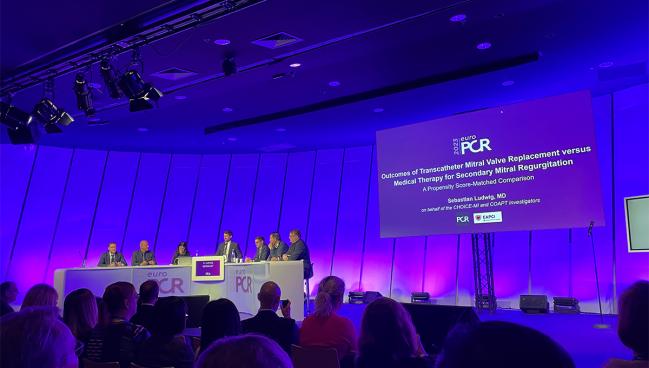Transcatheter MV Replacement vs Best Medical Therapy? Some Clues
A post hoc, propensity-matched comparison drawing on patients from CHOICE-MI and COAPT helps fill a gap while awaiting RCTs.

PARIS, France—A retrospective, nonrandomized comparison of outcomes in patients with functional mitral regurgitation (MR) treated with transcatheter mitral valve replacement (TMVR) versus optimal medical therapy (OMT) indicates that replacing the valve is linked to significant reductions in MR—not surprisingly—but also fewer heart failure hospitalizations and symptom improvement.
No differences were seen, however, in mortality out to 2 years.
“In the absence of randomized controlled trials, these results provide important preliminary evidence on the benefits of TMVR,” said Sebastian Ludwig, MD (University Heart and Vascular Center Hamburg, Hamburg, Germany), who presented the results here during a Wednesday morning hot line session at the EuroPCR 2023 meeting. The study was simultaneously published in Circulation: Cardiovascular Interventions.
Randomized trials of novel, transcatheter mitral valves have been inching towards completion in different parts of the world, but the field has not delivered a decisive win quite as quickly as many had hoped. Unlike aortic stenosis, mitral valve disease has more varied pathology and etiology, the valve itself is asymmetrical, and the saddle-shaped annulus and complex subvalvular anatomy pose hurdles for device placement and access.
For these reasons and more, trial investigators have sometimes struggled to ramp up enrollment, Ludwig told TCTMD. Given that all of the ongoing trials have typically tested a singled device, he added, “There is no data of comparisons between mitral valve replacement and medical therapy, that is, just continuing conservative treatment. We thought that this is really a gap in evidence, and we tried to fill this gap with some exploratory data.”
Filling a Gap
Ludwig and colleagues extracted patients who’d undergone TMVR and whose outcomes are being tracked in the CHOICE MI registry, using propensity matching to pair device recipients with similar patients who were randomized to guideline-directed medical therapy (GDMT) in the COAPT trial.
Ultimately, 97 patients from each data source were suitable for comparison and well-matched according to hemodynamic parameters as well as age, sex, body mass index, surgical risk score, and NYHA functional class.
Over 2 years follow-up, patients treated medically were far less likely to experience reductions in MR severity, and while improvements for both were seen in NYHA class over follow-up, these gains were significantly greater in the TMVR group.
All-cause mortality was 40.8% in the GDMT group as compared with 36.8% in the TMVR group, a nonstatistically significant difference.
First heart failure hospitalizations, however, were significantly reduced in the intervention group: 32.8% at 24 months as compared with 54.4% (HR 0.59; 95% CI 0.35-0.99).
The MR reduction was expected, said Ludwig, given the implantation of a device intended to regulate this problem. The improvements in NYHA class, however, were the “first important finding,” he said. Also notable, he added, were the symptomatic improvement and lower rate of heart failure hospitalizations, “which is important for patients with secondary MR.”
Awaiting Better Devices, Better Data
During the Q&A following his presentation, however, an audience question pointed out that the COVID-19 pandemic may have had an impact on the heart failure hospitalizations in the TMVR patients, since this cohort included those treated in the early years of the pandemic.
Moreover, the “elephant in the room,” as chair Fabien Praz, MD (Bern University Hospital, Switzerland), put it, is the fact that mortality did not track in the same direction.
In response, Ludwig stressed that the answer to this is “probably multidimensional” but likely relates to the difficulty of showing a survival benefit in patients whose primary disease is heart failure. While COAPT managed to eke out a win for a combined heart failure hospitalization/mortality benefit, the other randomized trial in this space—MITRAL-FR—was “neutral.”
What’s more, he continued, the analysis was not powered for mortality, and importantly, nearly all of the TMVR patients had undergone valve replacement via a transapical approach. Mortality might be lower, he noted, with newer-generation transeptal technology.
Indeed, Nicole Karam, MD, PhD (University of Paris, France), the session moderator, speaking with TCTMD afterwards, stressed that it’s important to keep in mind that 92% of the patients undergoing TMVR in this analysis had their procedures via a transapical approach.
“We know that the future for mitral replacement is not in transapical,” she said. “I would say, this analysis is the closest we can get to a comparison of what the yield of replacement [might be], but it’s not randomized [and] we have to keep in mind. I guess what this study brings is the yield of transapical [versus OMT] and that’s not perfect yet.”
Panelists also pointed out that the CHOICE MI registry captured the early learning curve with TMVR, with many of the early cases being the very first ones attempted across multiple centers, something that would have influenced outcomes down the road. On the other hand, COAPT patients were enrolled prior to the advent of SGLT2 inhibitors for heart failure, while use of angiotensin receptor-neprilysin inhibitors was very low.
Asked about the outdated “best medical therapy” in the COAPT GDMT patients, Ludwig agreed that this was a shortcoming of the OMT cohort, but noted that use of both agents was also low in the TMVR group, with just 3-5% of patients getting an SGLT2 inhibitor. “So, I don’t think it would make a big difference," he said to TCTMD.
While some MR patients will respond well to newer and better medications, there will always be some who do not, he stressed.
“I do think there is a treatment gap," Ludwig continued. "There are anatomies that cannot be treated sufficiently with [transcatheter edge-to-edge repair], that would not benefit from medical therapy, and that cannot undergo surgery because they are high risk. So, I think there is a need for TMVR, but we still have to find the optimal device and the optimal access route, and I think this is probably why mortality does not show a difference. We are still, I think, at the early slope of the learning curve.”
Shelley Wood was the Editor-in-Chief of TCTMD and the Editorial Director at the Cardiovascular Research Foundation (CRF) from October 2015…
Read Full BioSources
Ludwig S, Conradi L, Cohen DJ, et al. Transcatheter mitral valve replacement versus medical therapy for secondary mitral regurgitation: a propensity score-matched comparison. Circ Cardiovasc Interv. 2023;Epub ahead of print.
Disclosures
- Ludwig reports receiving grants/research support from the German Heart Foundation, and honoraria or consultation fees from Abbott, Bayer, and Edwards Lifesciences.





Comments